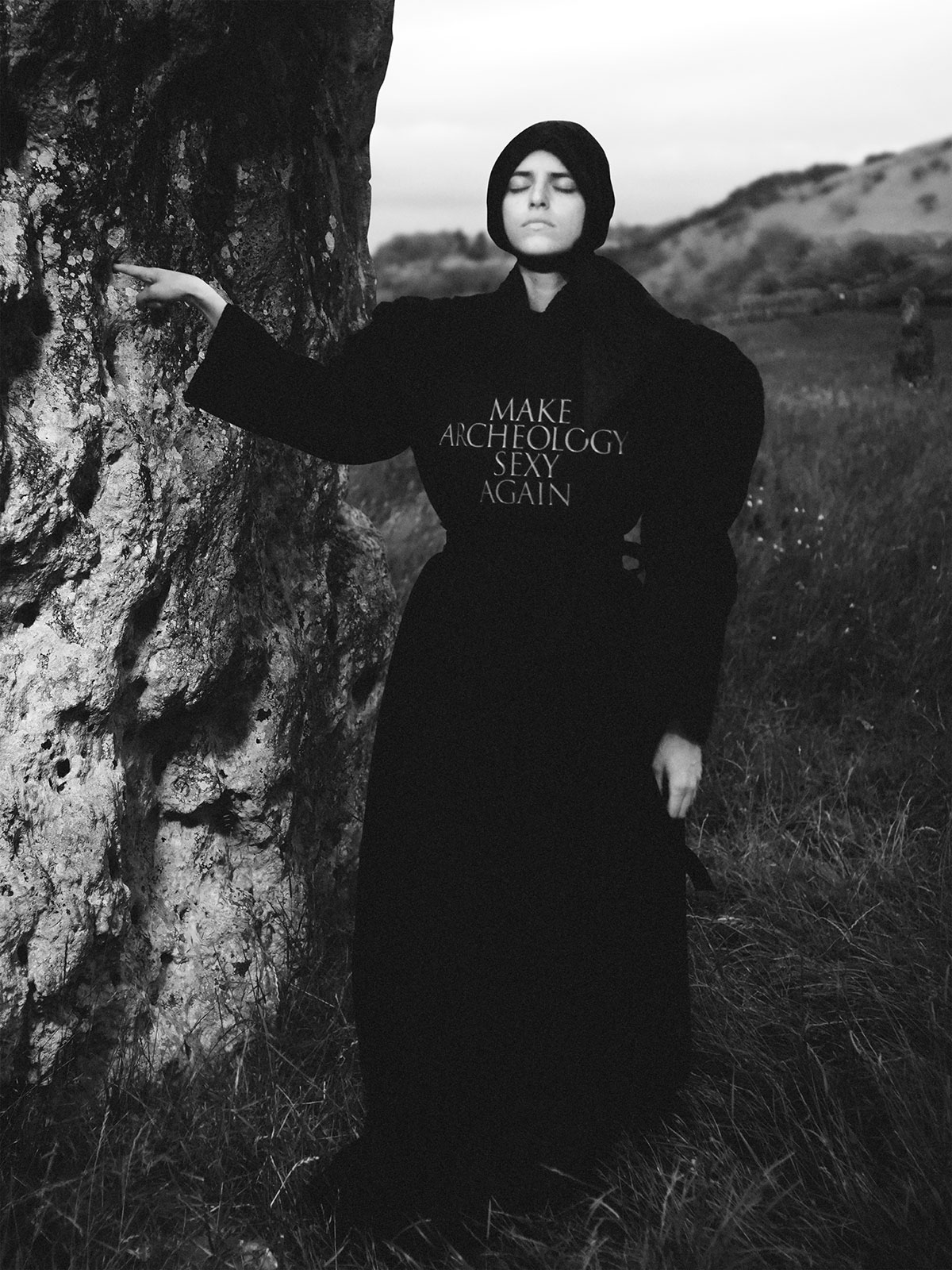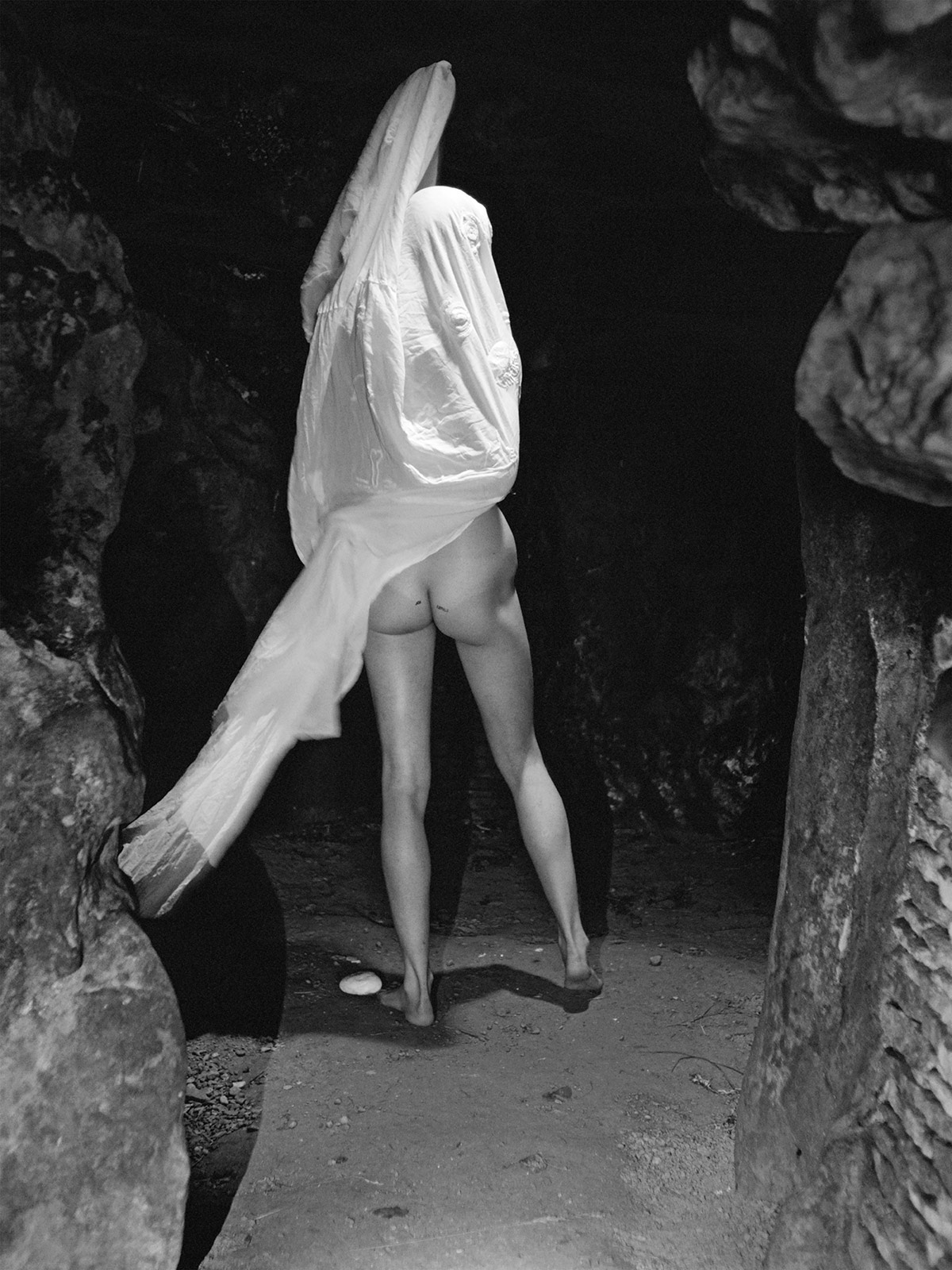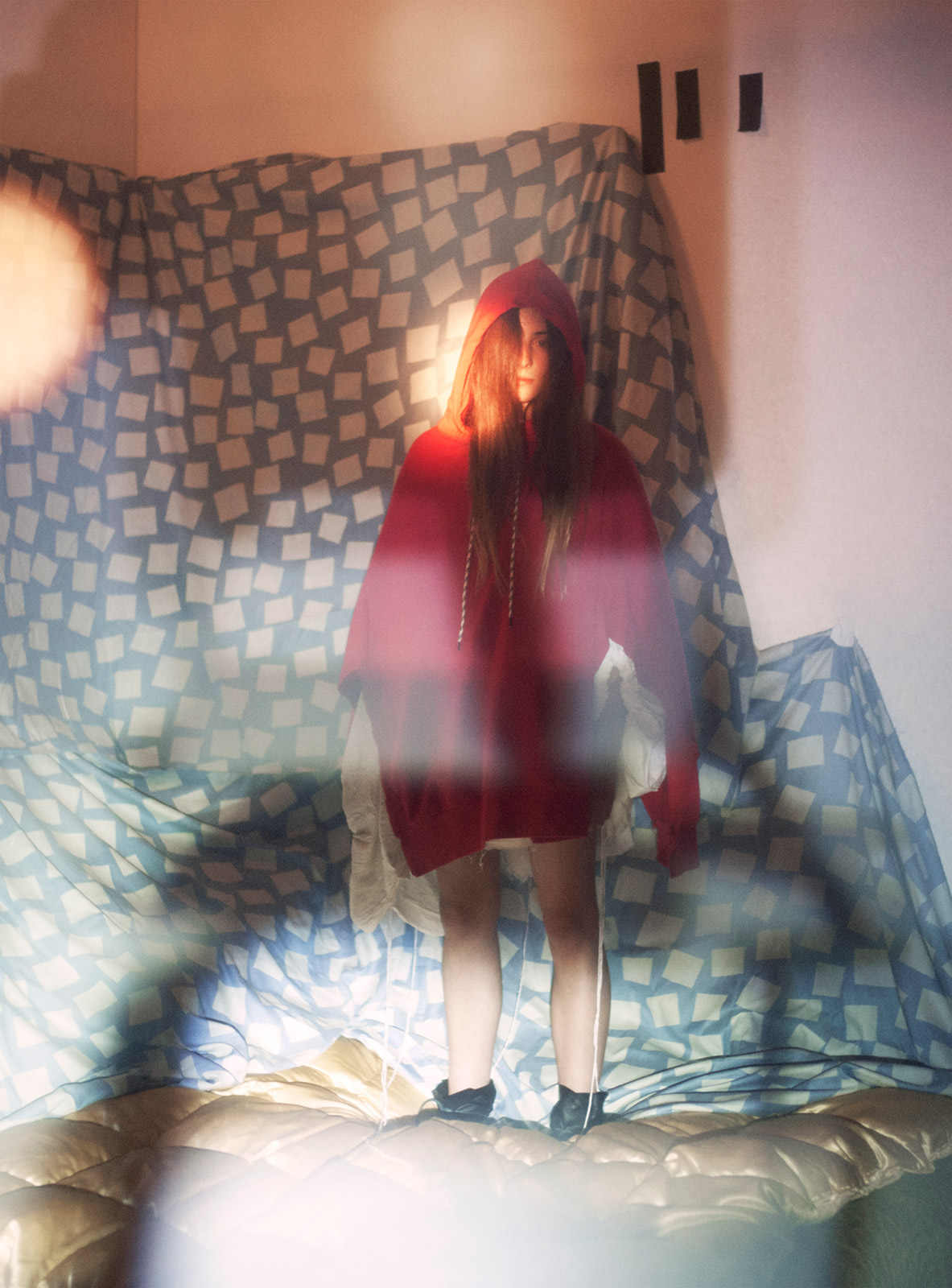Aries designer Sofia Prantera talks to Document about acid rave, ancient artifacts, and shooting a fashion campaign at the world's most famous Neolithic monument.
“I see Aries as a vehicle for different ideas and collaborations, and this in turn frames the clothing we produce,” says Sofia Prantera of her cult fashion brand Aries, co-founded in 2012 with Fergus Purcell. Prantera’s latest collection is the cumulative effort of a trifecta of British creative heavyweights, including photographer David Sims and artist Jeremy Deller. Arriving as British identity is being redefined and reduced by Brexiters in the UK Houses of Parliament, Prantera is interested in expanding the definition, while looking beyond the present to the prehistoric. The capsule collection—titled Wilshire Before Christ—is built on graphics culled not just from subcultures but from ancient civilizations, including our Neolithic ancestors at Stonehenge and Avesbury. The acid rave smiley face—Prantera moved from Italy to London during the genesis of the rave era, and some professors claim Stonehenge was itself a “neolithic rave venue”—appears alongside pagan symbols, a Brutalist dick pic, and the slogan “MAKE ARCHAEOLOGY SEXY AGAIN.” From prehistoric religion to acid rave, it’s all about congregation, the collective experience, and finding creative ways of breaking down societal divides. “[Rave] was a catalyst of change,” Prantera says, “and promoted equality in a way that, as part of it, was not clear to me at the time.” Creative collaboration is also integral to Deller’s work on artistic ego—the Turner prize-winning artist created a centenary celebration at Stonehenge last year.
The new collection includes 30 pieces plus a range of merch, and is presented as artifact as part of an immersive exhibition at at The store X in London. Aries and Sims are also releasing a book in the style of of a guide to Britain’s Neolithic sites, which contains over 50 images shot by Sims and styled by Jane How, plus an introduction by archaeologist Julian Richards. Document spoke to Prantera about rave nostalgia, the power of symbols, and shooting a fashion campaign at the world’s most famous prehistoric monument.
Hannah Ongley—Was Stonehenge always intended to be a part of the release? If not, how did this context alter your conception of the actual product?
Sofia Prantera—The whole project was very much a process. I like working in this way, without a fixed goal at the beginning, open to what might develop. It is what makes working with others so interesting. It started with the T-shirt collaboration between Jeremy, Aries, and English Heritage; from the beginning it was intended for the Stonehenge gift shop. Both Jeremy and I love product and designing it together was very easy. Every time we met we thought of more things we could make. Stonehenge is a symbol; the simplicity and immediateness of the Trilithon shape has the power of an ancient brand, it encapsulates a sense of history, mystery, and longevity while being immediately recognizable, and the Trilithon was always meant to feature on some of the product. Stonehenge is the ultimate brand, and for someone like me, who started working in the 90s as part of skateboarding culture, logo repurposing and appropriation are at the root of all collaborations; but the possibility of photographing at the site wasn’t an option at the beginning and this is when David [Sims] became involved, and the project took a different shape.
Hannah—The collection references rave culture and some theories suggest Stonehenge was a neolithic rave venue. What is your personal connection to the rave scene?
Sofia—I moved to London at the beginning of the rave movement and it was my first real brush with club culture and going out. I was part of an acid house project at the time, but I was very young and I never felt it really belonged to me. Only now I realize it was a very important part of my development as a designer and individual. Coming on the back of punk and other more political movements, rave always felt very hedonistic and not culturally relevant, like a movement without manifesto. Yet, looking back now, its meaning and legacy are becoming clearer; the way it helped breaking down the British class system, and changed the way youth gather and interact. Whether it was the product of the terrible recession Britain suffered in the 1980s or just a coincidence, it was a catalyst of change and promoted equality in a way that as part of it was not clear to me at the time.
Hannah —Why do you think there is a nostalgia for rave culture in 2019?
Sofia—Nostalgia for past movements is inevitable, and now that the people involved have grown up it is part of the nostalgia we feel for our youth and simpler past.
Hannah—The smiley face image also reminds me of emojis and meme culture, which are a modern example of how we use symbols to communicate. What can symbols satisfy that language can’t?
Sofia—Instagram has introduced us to a new way of communicating—or reintroduced us to an old one? It is very simplified but not necessarily less sophisticated. Symbols and images have replaced words, they can be difficult to navigate but are also very direct. I think men have been perennially fascinated by symbols; the monograms of contemporary brands exploit the same power explored for the first time with Neolithic painting, and later with hieroglyphics, alphabets, and religious iconographies. Modern communication exploits these symbols without the need for explanations. It is the idea of being able to encapsulate a potentially complex concept in a very simple and direct sign. They are open to interpretation, therefore appear more profound.
Hannah—Do you think our desire for collective experiences is closely tied to politics and culture? We seem to be distancing ourselves not just from religion but from capitalist ideology and the myth of the individual, which reminds me a lot of Jeremy’s work about ego, as well as the k-punk concept of acid communism.
Sofia—I worry that the opposite is true; I think there are definitely growing anti-capitalist feelings and movements in some circles, but as a whole I fear, and I think Mark Fisher did too, that neoliberalism and free-market capitalism ideologies are too deeply rooted into our way of thinking; these ideas have been actively promoted by big corporation since the 1950s, and their values have been introduced in education and public opinion in such an insidious way that they have left us unable to imagine a viable alternative. There has been a constant stream of investment over the past 60/70 years in promoting capitalist ideals in education, ethics, and law especially, which has drastically changed the way we think and interact, and the values promoted will be very difficult to eradicate for generations to come.
Hannah—How do you balance, in fashion, the need to be commercial with the appeal of the “cult”? Are they opposite sides of a coin or are they intertwined?
Sofia—With difficulty, but “cult” is definitely not so relevant in fashion anymore—you can now buy cult and cool, which is a relatively new idea. When I started in fashion, collaborating with large companies was seen as selling out. Now most small businesses use collaboration as a way of funding. Instagram followers have become the biggest currency, and it is odd because you can buy those too.
Hannah—The collection also references immigrants and the idea that Stonehenge itself was built by migrants. What can you tell us about the genesis of these pieces?
Sofia—We don’t know what Stonehenge was originally built for, and the place is still shrouded in mystery, but for me the most interesting discovery was reading that recent developments in genetics and DNA sequencing have established that the human remains found in Stonehenge were not of local populations, but like some of the stones themselves were brought in from far away; prehistoric British populations were most probably nomadic and of Arab origin and it was only subsequently, and at around the time Stonehenge was built, that these original populations were almost entirely replaced by an influx of northern Beaker People which brought in the genes for paler skin and blue eyes. So the immigrant references seemed very apt and reminiscent of today’s political climate.







































